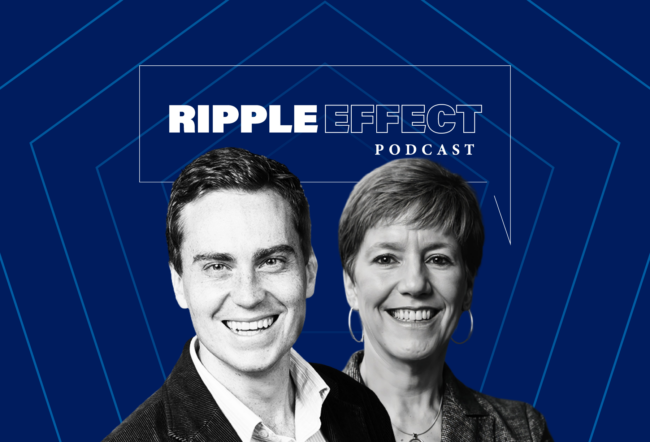“I love creating models and coming up with explicit structures I can play with,” says Edward C. Prescott. “Economists create their own worlds. We’re like little gods with our artificial economics, wanting to see what happens.”
Last month Edward C. Prescott and Finn E. Kydland won the 2004 Nobel Prize in Economic Sciences for two important papers they coauthored that advanced the field of dynamic macroeconomics. As the Royal Swedish Academy of Sciences put it, Prescott and Kydland’s work “has not only transformed economic research, but has also profoundly influenced the practice of economic policy in general, and monetary policy in particular.”
More to the point, the two papers cited by the Swedish Academy hammered the final couple of nails in the coffin of Keynesian macroeconomic theory by changing the way economists think about the design of economic policy and the causes of business cycles. The first of the two papers singled out by the Swedish Academy, called “Rules Rather Than Discretion: The Inconsistency of Optimal Plans,” was published in 1977 in The Journal of Political Economy. The second paper, “Time to Build and Aggregate Fluctuations,” appeared in Econometrica in 1982.
Prescott and Kydland have long been respected for successfully combining theory and applied economics. Their work together has focused on the interaction between theory and a society’s aggregate statistics such as the level of unemployment, inflation and productivity. Prescott, an economics professor at the W.P. Carey School of Business at Arizona State University, has been a research adviser at the Federal Reserve Bank of Minneapolis for 23 years. Kydland is an economics professor at Carnegie Mellon University and the University of California, Santa Barbara. Kydland was initially a graduate student of Prescott’s at Carnegie Mellon.
Between the Depression and the early 1970s Keynesian economic theory reigned. John Maynard Keynes made the case that monetary policy could – and should – be used to stabilize economies and keep unemployment low. The assumption at the time was that inflation and unemployment were inversely correlated, so as one went up, the other went down. What was key was managing the demand side of the supply and demand equation. If unemployment was high, a central bank should therefore pursue an expansionary monetary policy to combat unemployment by, for example, increasing the monetary supply or lowering the overnight federal funds rate, a key interest rate. Following either path would make borrowing funds cheaper and would encourage companies to make capital investments such as building new factories and developing new technologies, which would boost employment.
The 1970s threw a monkey wrench into Keynesian macroeconomic theory, which said that inflation and unemployment couldn’t both be high at the same time. But they were, and efforts to fight inflation failed. That, coupled with the oil crisis in 1973 and the subsequent worldwide recession, exposed some of the central cracks in traditional top-down Keynesian economic theory.
Economists such as Milton Friedman and Edmund Phelps had already expressed skepticism over some aspects of Keynesian theory, but it was Robert Lucas, an economics professor at the University of Chicago who was awarded the Nobel Prize in 1995, who provided the theoretical framework that showed its fundamental insufficiencies. In a number of papers in the 1970s, culminating in a 1976 paper that became known as the “Lucas Critique,” Lucas made it clear that no monetary policy that didn’t take into account the ever-shifting behavior of individuals trying to make the best decisions for themselves would be viable. These small decisions, which incorporate information about the economy and expectations about future policy decisions, influence bigger changes in the overall economy, Lucas said.
Prescott, who was trained as a statistician, credits Lucas and Phelps with getting him interested in economics. “I liked that general equilibrium language – with models and people, with substitution and thinking about what these people are doing in their environments, with borrowing and lending and knowing that there’s somebody on each side of any exchange or contract,” says Prescott.
(A general equilibrium model refers to a model of the economy that takes into account all aspects of that economy, and in which individuals, companies and institutions like the central bank make decisions they consider the smartest and most appropriate at the time. Substitution refers to the decisions individuals make such as the decision to spend money now or save it for the future.)
Prescott, who was influenced early on by Lucas, had arrived at Carnegie Mellon as a graduate student in 1963, the same year Lucas joined the university as an assistant professor. After receiving his PhD four years later, Prescott taught at the University of Pennsylvania. Lucas and Prescott began working together and published a paper called “Investment Under Uncertainty” in 1971 and another called “Equilibrium Search and Unemployment” in 1974.
Meanwhile, Prescott had returned to Carnegie Mellon in 1971. For the next three years at Carnegie Mellon, “Lucas and I had a number of outstanding graduate students,” says Prescott. “I think I did not scare them as much as Lucas did.”
One of those advanced graduate students was Kydland, and Prescott soon became his thesis adviser. After receiving his PhD in 1973, Kydland, who was Norwegian, returned to teach at the Norwegian School of Economics and Business Administration in Bergen. He arranged for Prescott to visit there in the 1974-75 academic year. That spring they wrote their paper on time-inconsistency, which was published two years later. Their paper on business cycles was written in the summer of 1980 when Kydland and Prescott were both back at Carnegie Mellon.
The Problem of Time-Inconsistency
In “Rules Rather Than Discretion,” their 1977 paper, Prescott and Kydland established that a monetary authority’s policy decisions are often time-inconsistent. This means that monetary policy changes intended to remedy an immediate problem such as unemployment will often have unintended ramifications that work against the stated goal of reducing unemployment.
When a government announces a remedy to a short-term problem, individuals and companies adjust their behavior and make new decisions based on that information. Those decisions change the economic landscape, reducing the incentives the government had in the first place for wanting to institute the policy changes. Thus, if a government has the discretion to pursue any policy it wants, given the particular economic situation on the ground, and can’t remain committed to the promises it makes, it will face what Prescott and Kydland called a credibility problem. To counter this, it is wiser for a central bank to focus on long-range goals and not interfere in the economy too aggressively by trying to boost employment or stimulate demand in the short run.
This was a “fundamental paper,” says Amir Yaron, a finance professor at Wharton. “They showed that the central bank’s policy today has ramifications [as to] what people anticipate the central bank will do in the future and consequently on what those people do – and that has a feeding effect on what will happen in the future. The paper made clear that the notion of being consistent with your policy across time, as opposed to thinking about what’s optimal right now, is very important.”
Prescott and Kydland’s time-inconsistency paper did not set out to prove what the paper ultimately proved. The two had hoped to find an accommodation between control theory, which represented a more traditional, activist approach to monetary policy, and the Lucas critique. They found, however, that the best policies in their model were not time-consistent. Eventually they realized that this wasn’t a problem but the “punch line,” says Prescott.
An example the authors gave in their paper involved flood insurance. A government clearly wouldn’t want to subsidize flood insurance in a flood-prone area because that would encourage people to build there. However, if the government says it won’t subsidize flood insurance but then bails people out after a flood, individuals will expect the bailout and will build in flood-prone areas anyway. The solution is therefore to prohibit building in the flood-prone areas.
Richard Rogerson, an economics professor at ASU’s William P. Carey School of Business, explains the time-inconsistency dilemma in terms that are even simpler. He points out that parents who threaten to punish their children often display a time-inconsistency problem. A parent who wants to produce a certain behavior may tell a child not to do something or he will punish the child. “The hope is to influence behavior,” says Rogerson. “But the kid figures out that the parent doesn’t want to punish him, so he knows that if he does it again he won’t be punished. The parent thus has a time-inconsistent policy and cannot achieve what he wants.”
Following Prescott and Kydland’s argument, individuals are better off when the Federal Reserve Bank’s intentions are clear, consistent and credible. If the Fed has the discretion to change course, the result will always be less good because there will be more uncertainty about inflation, wages, interest rates, unemployment, etc. That could lead to “random distributions” in the level of these variables, to borrow the language Prescott and Kydland used.
“Random distributions are not good things, because people are risk-averse, and this risk adversely affects their welfare,” says Prescott. “If you get too much price uncertainty, all kinds of long-term, mutually beneficial contracts can’t be entered into.”
He explains this with an example from his own life. In 1981 when Prescott moved to Minneapolis, he had to sell his house in Pittsburgh and buy one in Minneapolis. But at the time there was tremendous uncertainty about the future level of interest rates. “The mortgage markets were virtually shut down, so I had to issue a mortgage to the buyer to sell my house. A similar thing had to be done here in Minneapolis; the people from whom I bought the house had to issue me a contract for deed,” says Prescott. “A few years later when the system became stable again, I got a regular mortgage. But there’s a lot of risk when you issue a mortgage, and I’m risk-averse.”
The research Prescott and Kydland did on time-inconsistency led to a focus on how central banks could be strengthened and made more independent in order to ensure their credibility in the face of short-term changes in the economy. “Once you understand that credibility is an issue, that emphasizes the need for institutions to solve or minimize the time-inconsistency problem,” explains Rogerson.
In the wake of this research, many central banks around the world have committed themselves to a long-range policy – implicit or explicit – of seeking low inflation. The United States, for instance, has an implicit policy of pursuing low inflation. Since the early 1990s, a number of countries, including New Zealand, Sweden and the United Kingdom, have instituted a policy of inflation targeting – a specific range for inflation that the central bank commits to pursuing. Many of these changes by central banks around the world are the direct or indirect result of Prescott’s and Kydland’s work in this area, notes Rogerson.
Supply-Side Realities
The second influential paper by Prescott and Kydland mentioned in the Nobel citation was “Time to Build and Aggregate Fluctuations.” This paper turned Keynesian theory upside down by finding that business cycles were caused by supply-side shocks rather than shocks to a society’s aggregate demand.
One of the cornerstones of Keynesian theory was that a well-functioning economy should have no business cycles – no bouts of high inflation or persistent unemployment. “So if there are cycles, that’s an indication of a malfunctioning economy,” says Rogerson. “That idea permeated thinking for many years and was deeply ingrained. In effect, if an economy is in recession, someone should fix it.”
Prescott and Kydland’s business cycles paper showed that real, supply-side shocks – such as a hike in the price of oil or hurricanes hitting Florida or the invention of a new technology – by and large account for the business cycles in a well-functioning economy. “Business cycles are therefore not the result of a malfunctioning economy,” says Rogerson. “It’s the economy responding to shocks that hit it – and policymakers must therefore think differently about business cycles.”
When Prescott and Kydland wrote their paper, the belief was that business cycles were driven by demand shocks such as a collapse of consumer confidence, which meant that monetary policy could play a significant role in smoothing out the business cycle and alleviating those shocks. “Prescott and Kydland presented a radically different view of the world,” says Wharton’s Yaron. “If these are supply shocks, there’s not much role for the Fed to smooth them out with monetary policy. That was an eye-opener.”
In addition to changing the course of research on business cycles, that paper was also influential for pioneering a technique called calibration. Prescott and Kydland advanced a methodology by which macroeconomists could evaluate models in a quantitative manner. “Their model had an explicit role for dynamics and shocks and optimizations [individuals making decisions based on changing factors in the economy in order to achieve their goals] that are quantitatively taken into account,” says Yaron. “Before that, this combination of giving shocks [such as the development of a new technology] an explicit role in a model and letting agents do full optimization was not something you saw in macroeconomics.”
“Their calibration procedure showed how you can take abstract formal models and use them to talk about things in the real world, and to quantify what’s happening in the model,” adds Rogerson.
A subsequent paper by Prescott, co-written with Rajnish Mehra, a finance professor at the University of California, Santa Barbara, also spawned a large academic literature. The 1985 paper, called “The Equity Premium: A Puzzle,” identified a puzzle: that over the course of the 90 years ending in 1978, stocks in real terms had paid a yearly average of 6 percentage points more than Treasury bills. The magnitude of that difference, the professors noted, couldn’t be adequately explained by existing models.
There are some “candidate answers,” but none that are fully satisfactory or accepted, says Yaron. He notes that “Prescott and Mehra’s contribution lies in highlighting why the equity premium was puzzling, and putting a discipline on how alternative explanations need to be evaluated.”
Prescott says he sees economics as a “tool-driven science” and that economists nowadays have more tools to solve problems than they ever did. “This is a golden age and there are great questions to be addressed,” he observes. The Nobel Prize notwithstanding, Prescott remains interested in large societal issues.
“I’d like to know why Latin America has been lagging in economic development,” Prescott notes. “It’s been staying 75% behind the leader for the last 100-plus years. Why hasn’t it caught up?” Another problem is how a nation can set up a retirement system that is not defaulted on. “Promises are made and people save and then the promises are not honored by society,” Prescott says. “After World War II there were a lot of pension funds in Europe that were fully funded, but they were pressured to hold a lot of government debt. There was a lot of inflation, and the value of all those assets fell. Those pension funds couldn’t honor their promises to the people.”
When Prescott returns from Stockholm, Nobel Prize in hand, those questions – and others – will presumably be awaiting him.



